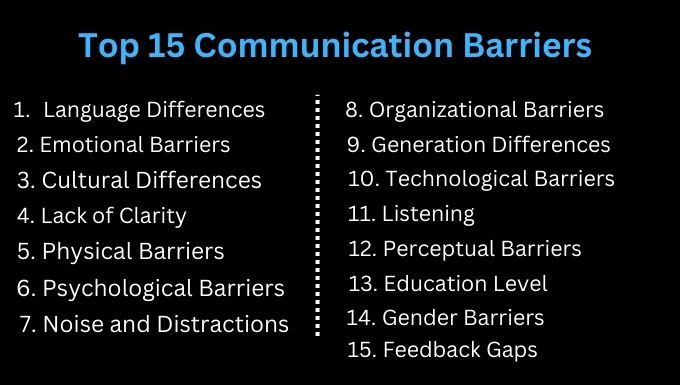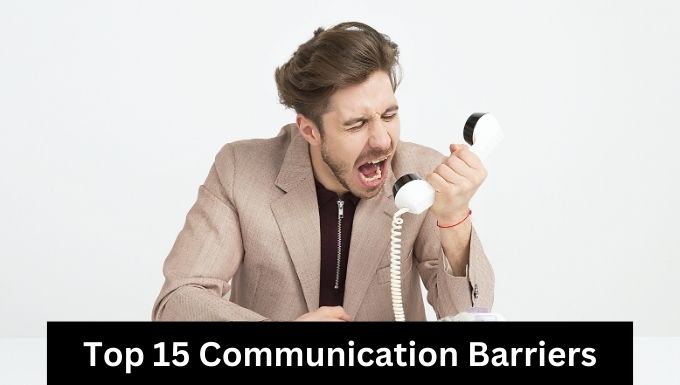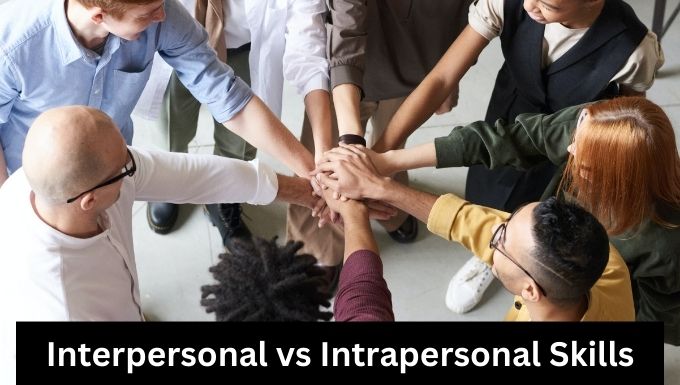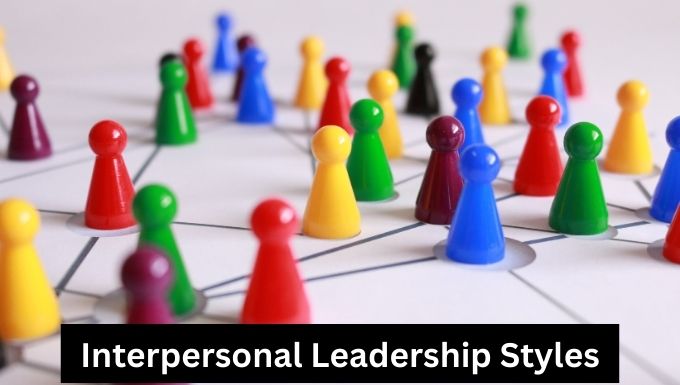Communication is the heart of any relationship. But sometimes, communication barriers block your words from reaching others. And transform a simple discussion into a puzzle.
Let’s explore the top 15 communication barriers and learn how to overcome them.
Table of Contents
What are Communication Barriers?
Communication barriers block information flow. It often results in misunderstandings, confusion, and sometimes frustration. And common factors include clarity issues, language differences, and noisy environments.
Top 15 Communication Barriers
Now, let’s discuss communication barriers in detail and how to overcome them.

1. Language Differences
When you speak different languages or use technical jargon, it creates a language barrier. As a result, effective communication becomes difficult, and misunderstandings arise.
How to Overcome: Use simple and clear language. Avoid technical jargon while speaking. And use translation services for multilingual communication.
Remember, when spoken language seems difficult, use visual communication methods like diagrams and images to convey your message.
2. Emotional Barriers
Do you know that emotions like anger, fear, or stress disrupt communication? Because these emotions lead to misunderstandings and make the communication process complicated.
How to Overcome: When emotions run high, it’s critical to acknowledge them and employ empathy. Take a moment to calm down before addressing significant matters.
And try to understand the other person’s perspective. That boosts a sense of connection and trust during communication.
3. Cultural Differences
Different cultural backgrounds have different communication styles and values. These differences create significant barriers to effective communication. It’s because, without acknowledgment and respect, this could lead to conflict.
How to Overcome: The key to overcoming cultural differences is to be open-minded and respectful of other cultures. Learn about different cultures’ customs and communication norms.
Moreover, try to establish strong interpersonal relationships with people from different cultures.
4. Lack of Clarity
Lack of clarity in communication occurs when your message is vague. Because that leads to misunderstandings, confusion, and misinterpretations.
How to Overcome: Express your thoughts in a concise way. And illustrate your points with real-life examples to make your message more relatable. Offer context and background information, especially when discussing complex topics.
5. Physical Barriers
Physical obstacles like distance, poor lighting, or even masks hinder communication. These elements disrupt the smooth flow of information. Because it creates challenges in understanding and conveying messages.
How to Overcome: Identify physical barriers and find appropriate solutions to improve communication. And when physical obstacles interrupt communication, use video calls, clear masks, or audio devices. Ensure proper visibility lighting and maintain eye contact.
6. Psychological Barriers
Psychological factors like personal opinions, assumptions, and mental states undermine effective interaction.
How to Overcome: Overcoming psychological barriers requires self-awareness. Therefore, practice empathy to understand the emotions and perspectives of others better. And engage in mindfulness techniques to stay focused during discussion.
7. Noise and Distractions
Environmental noise and distractions significantly disrupt communication. It’s because background noise and electronic devices divert your attention and make it challenging to focus on the conversation.
How to Overcome: Find a quiet environment for meaningful discussions and eliminate distractions. Use noise-cancelling headphones or choose an appropriate location for focused communication. Moreover, you can schedule specific periods for focused communication, minimizing distractions.
8. Organizational Barriers
Organizational barriers refer to things that make it difficult to communicate in the workplace. This could be because of strict rules, too much formality, or no easy way to share ideas.
How to Overcome: Promote open communication within your organization. Furthermore, develop a culture that values open dialogue and encourages employees to express their thoughts, regardless of their position.
9. Generation Differences
Different generations have different communication preferences. Understanding these differences and adapting communication methods is crucial to eliminating the generational gap. Because communication styles often vary across generations.
How to Overcome: Identify the communication preferences of people from different generations. And adapt your communication style to match your audience, whether older or younger.
Further, you can establish mentorship programs where people from different age groups can learn from each other.
10. Technological Barriers
Digital communication poses these barriers. Because technology lacks face-to-face communication. That makes it difficult to communicate clearly.
How to Overcome: Balance technology with face-to-face interactions. Use technology for its convenience, but be aware of its limitations. Because misuse of technology undermines effective communication, especially in conveying emotions and details.
11. Listening
Listening barriers undermine your ability to understand and engage in effective communication. No active listening and failing to understand the speaker’s perspective lead to poor communication.
How to Overcome: Practice active listening. Because active listening is the foundation of constructive communication. Pay close attention to the speaker, ask clear questions, and show genuine interest in their perspective.
12. Perceptual Barriers
These barriers occur when people have different perspectives, leading to misunderstandings. The differences in perspective, shaped by personal experiences, obstruct effective communication.
How to Overcome: Encourage open discussions to gain different perspectives. That helps bridge the gap and align perceptions. It’s vital to recognize the diversity of perspectives to improve communication.
13. Education Level
Communication challenges arise when you have different levels of formal education. Because differences in vocabulary, comprehension, and familiarity with certain subjects impact effective communication.
How to Overcome: Use simple language and avoid jargon. Be patient and adjust your communication style to ensure clarity.
Offer explanations for topics that may require background knowledge. Be patient and willing to answer questions or clarify points for those without the same level of education.
14. Gender Barriers
These barriers arise when people are treated differently or struggle to express themselves because of their gender. As a result, these obstacles cause misconceptions and unfair opportunities.
How to Overcome: To overcome gender barriers in communication, raise awareness of biases, and provide equal participation opportunities. These steps encourage open and fair communication. Moreover, that confirms everyone hears regardless of gender.
15. Feedback Gaps
Feedback gaps represent the absence of constructive feedback in communication. A lack of constructive feedback leads to ongoing communication issues. And without feedback, individuals or teams lose valuable insights for improvement and growth.
How to Overcome: Create an environment where feedback is encouraged and appreciated. Provide constructive feedback to others, and let others give you theirs.
In addition, schedule regular feedback sessions for employees and teams. Remember, feedback is critical for personal and professional growth.
FAQs
How do emotions impact communication?
Emotions hinder communication if not managed well. So, practice empathy and active listening to navigate emotional barriers.
What role does body language play in effective communication?
Body language plays a crucial role. Because your facial expressions and body postures convey unspoken messages and impact communication.
How to start a conversation with a stranger?
Your smile, eye contact, open-ended questions, and sharing a personal story are all effective ways to start a conversation with a stranger. Additionally, maintain friendly body language and respect boundaries.
Conclusion
Communication is not just about learning a skill; it’s a journey to better relationships and successful teamwork. Remember, the skill of communication develops with practice. And practice makes you more precise in your communication.
So, don’t let barriers block your way. Use the above tips to overcome communication barriers and enhance your communication skills. Hope you find this article helpful. Let us know in the comments.







Attractive section of content I just stumbled upon your blog and in accession capital to assert that I get actually enjoyed account your blog posts Anyway I will be subscribing to your augment and even I achievement you access consistently fast
Thank you for your kind words. I’m glad you enjoyed the content.
I appreciate your support and look forward to sharing more with you.
Stay tuned for updates!